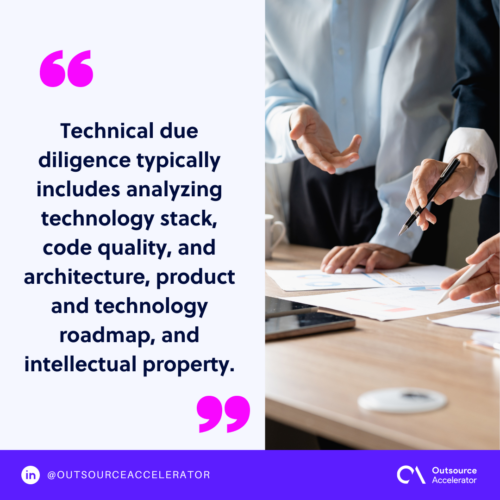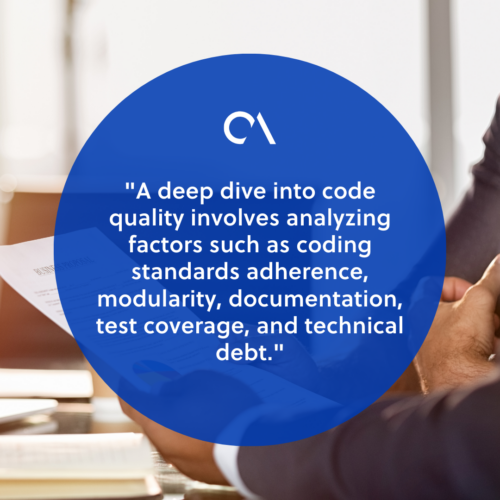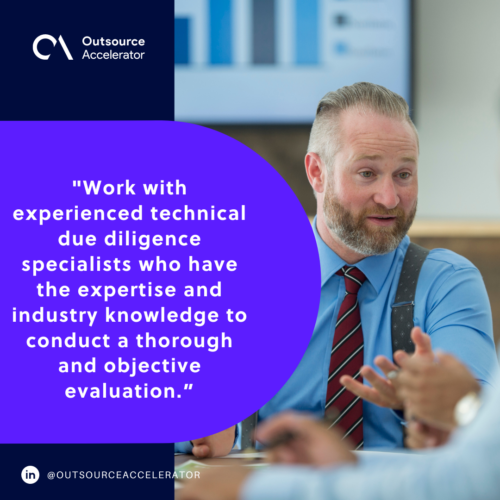Technical due diligence: A complete guide

Due diligence is a crucial step in mergers, acquisitions, and investments for various stakeholders, including venture capitalists and private equity firms.
This thorough examination process plays a vital role in assessing the target company’s financial health, operational efficiency, and growth potential. Due diligence lets investors uncover potential risks and make well-informed decisions aligned with their risk tolerance.
It is not merely a procedural requirement but a fundamental practice that making sound investment strategies and prudent decisions in corporate transactions.
While financial due diligence is typically the focus, ignoring technical due diligence can lead to significant risks and missed opportunities.
This comprehensive guide delves into the intricacies of technical due diligence, its definition, importance, process, and best practices.
What is technical due diligence?
Technical due diligence is the in depth process of evaluating the technological aspects of a company, product, or project. It involves a comprehensive examination of various technical elements to assess their strengths, weaknesses, opportunities, and risks.
Technical due diligence typically includes analyzing technology stack, code quality, and architecture, product and technology roadmap, and intellectual property.
The goal is to provide stakeholders (such as investors, acquirers, or partners) with a clear understanding of the technical aspects of the entity under consideration.
Stakeholders can make informed decisions regarding investments, acquisitions, or other strategic initiatives while mitigating potential technical risks and maximizing the value of the transaction.

Why is technical due diligence important?
Technical due diligence helps identify potential risks and challenges associated with a company, product, or project.
It gives stakeholders the capability to uncover issues such as code vulnerabilities, scalability limitations, or architectural weaknesses. They can then assess the magnitude of these risks and develop strategies to mitigate them effectively.
This evaluation process also provides insights into the quality and scalability of technological assets. It helps investors, acquirers, or partners gauge the intrinsic value and growth potential of the entity under consideration.
Here are additional reasons why technical due diligence is important:
- Customer impact – Identifying potential technical challenges early can prevent disruptions in service and maintain customer satisfaction.
- Regulatory compliance – Beyond assessing compliance with regulations, technical due diligence ensures that the technology adheres to industry-specific standards and best practices.
- Long-term viability – Understanding the scalability, flexibility, and maintainability of the technology under this process helps ensure its relevance and effectiveness over time.
- Cost optimization – Technical due diligence can identify opportunities for cost optimization by uncovering inefficiencies or redundancies in the technology infrastructure.
- Innovation potential – Assessing the technology roadmap and development practices can reveal the potential for future innovation. This helps identify areas where investments in research and development can drive technological advancement.
- Risk management – Beyond technical risks, it also assesses broader business risks that may arise from technology-related issues. This includes challenges related to cybersecurity, data breaches, system downtime, or vendor dependencies.
- Cultural fit – Ensuring compatibility in terms of development methodologies, innovation culture, and collaboration tools can facilitate smoother integration and post-transaction success.
Elements of technical due diligence
It’s essential to understand the various elements that comprise this comprehensive evaluation process.
Each element plays a crucial role in assessing a company’s technological landscape, providing valuable insights into its strengths, weaknesses, opportunities, and risks.
Technology stack assessment
The technology stack refers to the combination of programming languages, frameworks, libraries, and tools used to develop and operate a software application or system.
A thorough assessment of the technology stack involves evaluating its scalability, performance, security, compatibility, and maintainability.
Understanding the technology stack is crucial for assessing the feasibility of future enhancements, migrations, or integrations.
Code quality and architecture
The quality of software code and its underlying architecture significantly influences its stability, reliability, and maintainability.
A deep dive into code quality involves analyzing factors such as coding standards adherence, modularity, documentation, test coverage, and technical debt.
Assessing architecture involves understanding the system’s design principles, scalability patterns, data models, and integration points.

Product and technology roadmap
A clear and realistic product and technology roadmap is essential for outlining a company or project’s future direction.
Technical due diligence involves reviewing the roadmap to assess its alignment with business objectives, market trends, technological advancements, and competitive landscape.
An effective roadmap should address key milestones, feature enhancements, platform upgrades, and innovation initiatives.
Intellectual property assessment
Intellectual property (IP) assets, including patents, trademarks, copyrights, and trade secrets, play a critical role in protecting a company’s innovations and competitive advantages.
Further, technical due diligence involves conducting a thorough IP assessment to identify the following:
- Potential infringement risks
- Ownership disputes
- Licensing obligations
- Gaps in protection
The technical due diligence process
The technical due diligence process typically consists of the following stages:
Initiation and planning
The initiation and planning stage marks the outset of the technical due diligence process, setting the groundwork for subsequent activities.
During this phase, stakeholders convene to delineate the overarching objectives, scope, and establish a realistic timeline for the evaluation.
Collaboratively, they identify key areas of focus, whether it be examining the technology stack, assessing code quality, or evaluating architectural robustness.
With a clear understanding of the goals, criteria, and resource allocation, a comprehensive project plan is meticulously crafted to guide the due diligence endeavor.
Documentation review
Following initiation and planning, the documentation review stage delves into the wealth of technical documentation available. This entails an exhaustive examination of system designs, development methodologies, and infrastructure configurations.
In connection, due diligence support teams gain invaluable insights into the intricacies of the technology landscape. They uncover the nuances of the technology stack and gain visibility into the deployment environment.
Documentation review lays a solid foundation for subsequent assessments, providing a holistic understanding of the target entity’s technical capabilities and limitations.
Interviews and meetings
Subsequently, interviews and meetings take center stage as technical due diligence teams engage directly with key technical personnel.
They serve as invaluable opportunities to glean firsthand insights into the technology landscape from those closest to it. Through candid discussions, due diligence teams unearth critical nuances that may not be apparent from documentation alone.
These interactions enrich the findings from the documentation review as they help uncover the target entity’s technological strengths and weaknesses.
Code review
In the technical due diligence process, code review stands as a critical stage. Here, a meticulous examination of the source code is conducted to assess its quality, security, and maintainability.
Utilizing both automated tools and manual inspections, experts delve deep into the codebase to initiate the following process:
- Identify any potential vulnerability issues
- Ensure adherence to coding standards
- Uncover hidden issues
- Evaluate the overall health of the code
Compliance audit
Another integral aspect is the compliance audit. This stage involves a thorough review of the target company’s compliance with relevant regulations, standards, and industry best practices.
Experts examine adherence to security standards, data privacy regulations, software licensing agreements, and other legal requirements to identify any gaps or non-compliance issues.
By ensuring compliance with regulatory and contractual obligations, stakeholders can mitigate legal and regulatory risks associated with the investment or acquisition.
Moreover, compliance audits assure investors and acquirers, fostering trust and confidence in the target company’s operations and practices.
Follow-up and support
Following the completion of the due diligence process, the follow-up and support stage is essential for ensuring seamless transition and implementation of recommendations.
A detailed report summarizing the findings, recommendations, and action items is prepared and presented to stakeholders. Follow-up discussions may be conducted to address any questions, concerns, or additional information requests from stakeholders.
Moreover, ongoing support may be provided to assist with post-transaction integration, implementation of recommendations, or resolution of identified issues.
How to prepare for technical due diligence
Preparing for technical due diligence involves several key steps:
- Ensure that all relevant technical documentation, including architecture diagrams, system designs, and source code repositories, are well-organized and readily accessible.
- Assess the technology stack, code quality, security posture, and compliance status proactively to identify and address any potential issues or vulnerabilities.
- Educate key technical personnel about the technical due diligence process, their roles and responsibilities. Explain thoroughly the importance of providing accurate and transparent information during the evaluation.
- Anticipate potential questions and areas of scrutiny from due diligence teams. Prepare concise and comprehensive responses supported by evidence and documentation.
Best practices for technical due diligence
To ensure a successful technical due diligence process, consider the following best practices:
- Engage experienced professionals – Work with experienced technical due diligence specialists who have the expertise and industry knowledge to conduct a thorough and objective evaluation.

- Take a holistic approach – Consider the interdependencies and interactions between different technical components and factors rather than evaluating them in isolation.
- Focus on risk assessment – Prioritize the identification and assessment of technical risks and vulnerabilities that may impact the success of the investment or acquisition.
- Maintain confidentiality – Protect the interests of all parties involved by handling sensitive information and proprietary technology with the utmost confidentiality and discretion.
- Communicate effectively – Foster open and transparent communication between stakeholders, due diligence teams, and technical personnel to ensure alignment and clarity throughout the process.







 Independent
Independent




